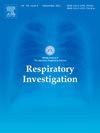A refined approach to chest tube removal: Impact of preoperative pleural fluid culture and nutritional status in non-fistulous empyema surgery
IF 2.4
Q2 RESPIRATORY SYSTEM
引用次数: 0
Abstract
Background
The acute pleural empyema guidelines recommend thoracoscopic-assisted surgery. However, there is no clear guideline for chest tube removal after surgery. This study aimed to evaluate the duration from surgery to chest tube removal, identify associated factors.
Methods
A retrospective cohort study was conducted in 95 patients having non-fistulous empyema due to pulmonary infection caused by common bacteria who underwent surgery at our hospital from January 2011 to March 2023. Postoperative lavage was conducted until two consecutive pleural fluid cultures were negative. The chest tube was clamped and removed if there was no exacerbation of fever or inflammatory findings for 2 days.
Results
Seventy-eight patients (82.1%) were men with a mean age of 72 years. The median duration from surgery to chest tube removal was 14 (interquartile range: 8–22) days. In the multivariable analysis, the independent factors associated with the duration from surgery to chest tube removal were lower prognostic nutritional index (hazard ratio [HR], 1.753; 95% confidence interval [CI], 1.101–2.792; P = 0.018) and positive preoperative pleural fluid culture (HR, 1.867; 95% CI, 1.069–3.261; P = 0.028). Ninety-two (96.8%) patients did not require additional treatment or rehospitalization.
Conclusions
Positive preoperative pleural fluid culture and nutritional status were significant independent factors associated with the duration from surgery to chest tube removal. Almost all patients did not require chest tube reinsertion in our approach. These findings using our approach may guide optimal management of chest tube removal in non-fistulous empyema.
一种改进的胸管拔除方法:术前胸腔积液培养和营养状况对非瘘性脓胸手术的影响
背景:急性胸膜脓胸指南推荐胸腔镜辅助手术。然而,手术后胸管拔除没有明确的指导方针。本研究旨在评估从手术到胸管拔除的持续时间,确定相关因素。方法对2011年1月至2023年3月在我院行外科手术的95例常见细菌所致肺部感染所致非瘘性脓胸患者进行回顾性队列研究。术后进行灌洗,直到连续两次胸腔积液培养呈阴性。如果2天内没有发热加重或炎症表现,则夹紧胸管并拔除。结果男性78例(82.1%),平均年龄72岁。从手术到取出胸管的中位持续时间为14天(四分位数范围:8-22天)。在多变量分析中,与手术至拔胸管时间相关的独立因素为较低的预后营养指数(危险比[HR], 1.753;95%置信区间[CI], 1.101-2.792;P = 0.018)和术前胸腔积液培养阳性(HR, 1.867;95% ci, 1.069-3.261;p = 0.028)。92例(96.8%)患者不需要额外治疗或再住院。结论术前胸腔积液培养阳性和营养状况阳性是影响手术至拔管时间的重要独立因素。在我们的方法中,几乎所有的患者都不需要重新插入胸管。这些发现可以指导非瘘性脓胸胸管拔除的最佳处理。
本文章由计算机程序翻译,如有差异,请以英文原文为准。
求助全文
约1分钟内获得全文
求助全文

 求助内容:
求助内容: 应助结果提醒方式:
应助结果提醒方式:


